| |
|
Xiamen Oil Paintings, Wholesale Direct!
|
|
100% hand painted, 100% cotton canvas, 100% money back if not satisfaction. |
|
|
|
|
ART WORKS INDEX
A
B
C
D
E
F
G
H
I
J
K
L
M
N
O
P
Q
R
S
T
U
V
W
X
Y
Z
|
|
ARTISTS INDEX
A
B
C
D
E
F
G
H
I
J
K
L
M
N
O
P
Q
R
S
T
U
V
W
X
Y
Z
|
|
|
|
|
|
|
|
|
|
 |
Nardo di Cione
|
|
Italian Byzantine Style Painter, active 1343-ca.1365
was an Italian painter, sculptor and architect from Florence. He was the brother of the more accomplished Andrea di Cione, called Orcagna, as well as Jacopo di Cione; they were important members of the Painter's Guild of Florence. While Orcagna has been noted as the more accomplished artist, Nardo developed his own unique style, described as a pronounced lyrical vein, a feeling for poetic values, strong human sympathies and great sensitivity to colour as a means of subtle differentiation and soft modeling. The brothers collaborated on a number of works from their studio together, including the decorations from the Cappella Strozzi in the Santa Maria Novella. While Orcagna painted the altarpiece, Nardo executed the frescoes of The Last Judgment, Paradise and Hell.
|
|
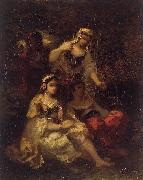 |
Narcisse Virgilio Diaz
|
|
August 25, 1807-November 18, 1876) was a French painter of the Barbizon school.
Diaz was born in Bordeaux to Spanish parents. At the age of ten, Diaz became an orphan, and misfortune dogged his early years. His foot was bitten by a reptile in Meudon wood, near Sevres, where he had been taken to live with some friends of his mother. The bite was poorly dressed, and ultimately he lost his leg. However, as it turned out, the wooden stump that replaced his leg became famous.
At fifteen he entered the studios at Sevres, first working in the decoration of porcelain occupied him and later turning to painting. Turkish and Oriental scenes attracted him, and he took to painting Eastern figures dressed in richly coloured garments; many of these paintings remain extant. He also spent much time at Barbizon.
At Fontainebleau Diaz found Rousseau painting his wonderful forest pictures, and was determined to paint in the same way if possible. However, Rousseau was then in poor health, embittered against the world, and consequently was difficult to approach. On one occasion, Diaz followed him surreptitiously to the forest, wooden leg not hindering, and he dodged round after the painter, trying to observe his method of work. After a time Diaz found a way to become friendly with Rousseau, and revealed his eagerness to understand the latter's techniques. Rousseau was touched with the passionate words of admiration, and finally taught Diaz all he knew.
Diaz exhibited many pictures at the Paris Salon, and was decorated in 1851. During the Franco-German War he went to Brussels. After 1871, his works became fashionable and rose gradually in the estimation of collectors, and he worked constantly and successfully. Diaz's finest pictures are his forest scenes and storms, and it is on these that his fame rests. There are several examples of his work in the Louvre, and three small figure pictures in the Wallace Collection, Hertford House.
|
|
|
|
|
|
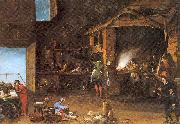 |
Napoletano, Filippo
|
|
Italian, approx. 1587-1629
Italian painter and engraver. From 1600 until at least 1613 he was in Naples, where the naturalism of landscape painters from northern Europe, particularly Paul Bril, Goffredo Wals ( fl 1615-31) and Adam Elsheimer, influenced his early development. After 1614 he was in Rome and became acquainted with the landscapes and seascapes of Agostino Tassi. In 1617 Cosimo II de' Medici summoned him to Florence, where he worked closely with Jacques Callot. Filippo sketched in the Tuscan countryside, and pen-and-wash drawings such as the Landscape with a Rustic House (Florence, Uffizi) capture effects of bright sunlight. He developed a new kind of realistic landscape, showing small scenes that suggest the charm of country life; examples are the Country Dance (1618; Florence, Uffizi), the Mill (Florence, Pitti) and the Fair at Impruneta (Florence, Pitti). In 1620-21 he produced a series of etchings of Skeletons of Animals, dedicated to the scientist Johann Faber, and in 1622 twelve etchings of Caprices and Military Uniforms (signed Teodor Filippo de Liagno).
|
|
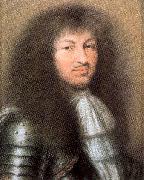 |
Nanteuil, Robert
|
|
French, 1623-1678
French engraver, draughtsman and pastellist. He was the son of Lancelot Nanteuil, a wool merchant, and submitted his thesis in philosophy, for which he engraved the headpiece, at the Jesuit College of Reims, in 1645. He went on to work in the studio of Nicolas Regnesson, whose sister he married in 1646, before moving to Paris in 1647. His early work mainly consisted of portrait drawings in black lead on parchment (e.g. Paris, Louvre), and he continued to draw throughout his career. He took 155 of his 221 portraits directly from life. His drawing style was influenced by Philippe de Champaigne, and he based his engraving technique on the work of Claude Mellan and Jean Morin.
|
|
|
|
|
|
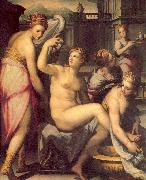 |
Naldini, Giovanni Battista
|
|
Italian, 1537-91
was an Italian painter of a late-Mannerism in Florence. His first apprenticeship (1549-57) was in the studio of Jacopo Pontormo. He went from Rome for a number of months following 1560, and was recruited to work for Giorgio Vasari in 1562. He painted two crowded, mannerist canvas for the Studiolo of Francesco I in the Palazzo Vecchio: the Allegory of Dreams and the Gathering of Ambergris. He supplied altarpieces to Santa Maria Novella and Santa Croce. He painted an altarpiece of Calling of Saint Matthew for the Salviati Chapel in San Marco, where he worked alongside Francesco Morandini. Ultimately, he is aptly described by Freedberg as displaying work distantly derivative from the style of Andrea del Sarto, as expressed by Naldini's two mentors and Sarto's two pupils: Pontormo and Vasari.
|
|
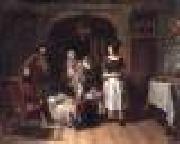 |
NAIVEU, Matthijs
|
|
Dutch painter (1647-1726)
Dutch painter. He was the son of a wine merchant from Rotterdam and began his training with Abraham Toorenvliet (c. 1620-92), a glass painter and drawing master in Leiden. From 1667 to 1669 Naiveu was apprenticed to the Leiden 'Fine' painter Gerrit Dou, who received 100 guilders a year (an exceptionally high sum) for instructing Naiveu. In 1671 Naiveu entered the Leiden Guild of St Luke, of which he became the head in 1677 and again in 1678, the year in which he moved to Amsterdam, where he was later appointed hop inspector. This work did not prevent him producing a considerable number of paintings; the earliest known work by Naiveu is dated 1668, the latest 1721.
|
|
|
|
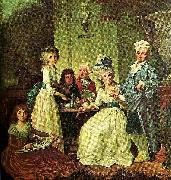 |
naigeon
|
|
(July 15 1738, Paris - 28 February 1810, Paris) was a French artist, atheist philosopher, editor and man of letters best known for his contributions to the Encyclop??die and for reworking Baron d'Holbach's and Diderot's manuscripts.
|
|
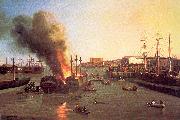 |
Nahl, Charles Christian
|
|
German-born American Painter, 1818-1878
later known as Charles Nahl, Karl Nahl, Charles Christian Nahl or Charles C. Nahl, was a German-born painter who is called California's first significant artist.He came from a long line of artists and sculptors and was trained at the Cassel Academy. Unease over the political state of Hesse led him and his friend Frederick August Wenderoth (1819-1884) to Paris in 1846, where "Charles" enjoyed some success at the salon. The February Revolution prompted another move with his half-brother Hugo Wilhelm Arthur Nahl (1833-1889) to Brooklyn, New York, where they heard of the gold strike. They had no luck along the Yuba River but opened a studio with Wenderoth in Sacramento
|
|
|
|
|
|
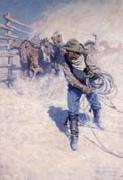 |
N.C.Wyeth
|
|
American Golden Age Illustrator, 1882-1945
|
|
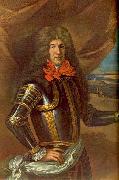 |
Musee national de la Marine
|
|
(National Navy Museum) is a maritime museum located in the Palais de Chaillot, Trocadero, in the XVIe arrondissement of Paris. It has annexes at Brest, Port-Louis, Rochefort (Musee National de la Marine de Rochefort), Toulon and Saint-Tropez. The permanent collection originates in a collection that dates back to Louis XV of France.
In 1748, Henri-Louis Duhamel du Monceau offered a collection of models of ships and naval installations to Louis XV of France, with the request that the items be displayed at the Louvre and made available to students of the Naval engineers school, which Duhamel headed. The collection was put on display in 1752, in a room of the first floor, next to the Academy of Sciences; the room was called "Salle de Marine" (Navy room), and was used for teaching.
With the French Revolution, the Salle de Marine closed in 1793. The collection was added to models owned by the King personally, to others owned by the Ministry of Navy, and yet others owned by emigres or executees (notably Philippe Égalite). A short-lived museum was opened between 1801 and 1803 at the Ministry of Navy, then located at Place de la Concorde.
|
|
|
|
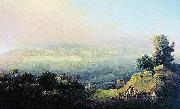 |
Maxim Nikiforovich Vorobiev
|
|
(1787-1855) was a Russian Romantic landscape painter.
Vorobiev was born into the family of a soldier, who on retirement became a guard in the Academy of Arts in St. Petersburg. There, Maxim was admitted in 1798 where he initially studied architecture but graduated as a landscape painter in 1809.
|
|
|
|
|
|
|
|
|
|
|
|
 |
Marianne North
|
|
(24 October 1830 - 30 August 1890), English naturalist and flower-painter, was born at Hastings, the eldest daughter of a Norfolk landowner, descended from Roger North.
|
|
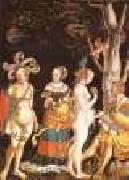 |
MANUEL, Niklaus
|
|
Swiss Northern Renaissance Painter, ca.1484-1530
was a Swiss dramaturg, painter, graphic artist and politician.
|
|
|
|
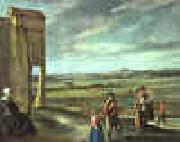 |
Louis Le Nain
|
|
1593-1648
French
Louis Le Nain Gallery
French family of painters. Antoine Le Nain (b Laon, c. 1600; bur Paris, 26 May 1648) and his brothers Louis Le Nain (b Laon, c. 1600; bur Paris, 24 May 1648) and Mathieu Le Nain (b Laon, c. 1607; bur Paris, 26 April 1677) lived together and shared a studio in Paris. Since the studio was headed by Antoine, he is assumed to have been older than Louis. The brothers reputation rests on a number of paintings signed Le Nain, on the basis of which other paintings (but no drawings) have also been attributed to them. None of the signed paintings bears a Christian name, and there is no secure way of attributing works to the individual brothers, although many attempts have been made. Eighteenth-century sale catalogues, fearful of anonymity, effectively chose from the three names at random. Since the writings of Witt (1910) and Jamot (1922) in particular, it has been habitual to ascribe small paintings on copper to Antoine, and austere, larger peasant scenes to Louis. This division of hands will be found in almost all the subsequent literature on the artists, although it must be stressed that there is no evidence at all to support it. Great efforts have also been made to identify works by Mathieu, since he survived his brothers by nearly 30 years and presumably continued to paint after their deaths in 1648. However, no such activity after 1648 is securely documented, and none of the surviving works bears a date later than 1647; and the arguments for a separate Mathieu oeuvre, though cogent, should not be regarded as conclusive. The outstanding feature of the work of the Le Nain brothers, and the basis of their celebrity since the mid-19th century, is the artists treatment of the poor.
|
|
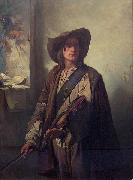 |
Louis Gallait
|
|
(9 or 10 May 1810 - 20 November 1887) was a Belgian painter. His d his reputation especially with the large painting of Charles V's abdication. Gallait's works were considered as the basis for a desirable renewal of historical paintings because of the realism, costume faithfulness and colorful posture of his paintings. His last artwork was sent on tour in Germany and that led to new signals even among German historians. He was also a distinguished portrait painter.
Gallait died in Brussels in 1887. There is a painting by Louis Gallait at the Norton Art Museum in West Palm Beach, Florida ("Art and Liberty").
|
|
|
|
|
|
|
|
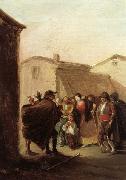 |
Leonardo Alenza Y Nieto
|
|
b Madrid, 6 Nov 1807; d Madrid, 30 June 1845
Spanish painter and illustrator. He studied at the Real Academia de S Fernando, Madrid, under Juan Antonio Ribera y Fern?ndez and Jos? de Madrazo y Agudo. He worked independently of court circles and achieved some fame but nevertheless died in such poverty that his burial was paid for by friends. He is often described as the last of the followers of Goya, in whose Caprichos and drawings he found inspiration for the genre scenes for which he became best known. Of these scenes of everyday life and customs the more interesting include The Beating (Madrid, Cas?n Buen Retiro) and Galician with Puppets (c. 1835; Madrid, Cas?n Buen Retiro; see SPAIN, fig. 17). Alenza y Nieto's numerous drawings include the illustrations for Alain-Ren? Lesage's Gil Blas (Madrid, 1840), for an edition of the poems of Francisco de Quevedo published by Castello and for the reviews Semanario pintoresco and El Reflejo. The painting Triumph of David
|
|
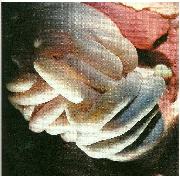 |
lennart nilsson
|
|
1992, intestines of a new-born baby . colour photograph. lennart nilsson photography ab, stockholm
|
|
|
|
|
|
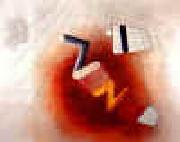 |
Laszlo Moholy-Nagy
|
|
Hungarian
1895-1946
was a Hungarian painter and photographer as well as professor in the Bauhaus school. He was highly influenced by constructivism. He was a strong advocate of the integration of technology and industry into the arts.
Moholy-Nagy was born L??szl?? Weisz to a family of mixed Jewish and Hungarian heritage. His cousin was Georg Solti. He changed his German-Jewish surname to the Magyar surname of his uncle, Nagy. Later, he added the pseudonym Moholy to his surname, after the town in which he grew up (Mol, today in Serbia). After studying law in Budapest and serving in World War I, Moholy-Nagy was in Vienna in 1919, where he first discovered constructivism in exhibitions of works of Malevich, Naum Gabo and El Lissitzky.
In 1923, he replaced Johannes Itten as the instructor of the preliminary course at the Bauhaus. This effectively marked the end of the school's expressionistic leanings and moved it closer towards its original aims as a school of design and industrial integration. The Bauhaus became known for the versatility of its artists, and Moholy-Nagy was no exception. Throughout his career, he became proficient and innovative in the fields of photography, typography, sculpture, painting, printmaking, and industrial design. One of his main focuses was on photography. He coined the term "the New Vision" for his belief that photography could create a whole new way of seeing the outside world that the human eye could not. His theory of art and teaching was summed up in the book The New Vision, from Material to Architecture. He experimented with the photographic process of exposing light sensitive paper with objects overlaid on top of it, called photogram. While at the Bauhaus, Moholy's teaching in diverse media -- including painting, sculpture, photography, photomontage and metal -- had a profound influence on a number of his students, including Marianne Brandt.
He was editor of the art and photography department of the European avant-garde magazine International Revue i 10 from 1927 to 1929. Moholy-Nagy resigned from the Bauhaus in 1928 and worked in film and stage design in Berlin, where he was required to submit his work to be censored, and then in Paris and Holland before moving to London in 1935. In England, Moholy-Nagy formed part of the circle of ??migr?? artists and intellectuals who based themselves in Hampstead. Moholy-Nagy lived for a time in the Isokon building with Walter Gropius for eight months and then settled in Golders Green. Gropius and Moholy-Nagy planned to establish an English version of the Bauhaus but could not secure backing, and then Moholy-Nagy was turned down for a teaching job at the Royal College of Art. Moholy-Nagy made his way in London by taking on various design jobs including Imperial Airways and a shop display for men's underwear. He photographed contemporary architecture for the Architectural Review where the assistant editor was John Betjeman who commissioned Moholy-Nagy to make documentary photographs to illustrate his book An Oxford University Chest. In 1936, he was commissioned by fellow Hungarian film producer Alexander Korda to design special effects for Things to Come. Working at Denham Studios, Moholy-Nagy created kinetic sculptures and abstract light effects, but they were rejected by the film's director. At the invitation of Leslie Martin, he gave a lecture to the architecture school of Hull University.
In 1937, at the invitation of Walter Paepcke, the Chairman of the Container Corporation of America, Moholy-Nagy moved to Chicago to become the director of the New Bauhaus. The philosophy of the school was basically unchanged from that of the original, and its headquarters was the Prairie Avenue mansion that architect Richard Morris Hunt designed for department store magnate Marshall Field.
Unfortunately, the school lost the financial backing of its supporters after only a single academic year, and it closed in 1938. Paepcke, however, continued his own support, and in 1939, Moholy-Nagy opened the School of Design. In 1944, this became the Institute of Design. He authored an account of his efforts to develop the curriculum of the School of Design in his book Vision in Motion.
Moholy-Nagy died of leukemia in Chicago in 1946.
|
|
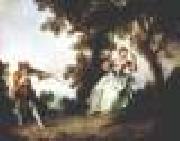 |
LANCRET, Nicolas
|
|
French painter (b. 1690, Paris, d. 1743, Paris).
French painter, draughtsman and collector. He was one of the most prolific and imaginative genre painters of the first half of the 18th century in France, and, although after his death he was long regarded as a follower and imitator of Antoine Watteau, his work is markedly personal and often innovative. He began training as an engraver but soon apprenticed himself to Pierre Dulin (1669-1748), a moderately successful history painter; by 1708 he had enrolled as a student at the Academie Royale de Peinture et de Sculpture, Paris. At an unknown date he entered the workshop of the genre and decorative painter Claude Gillot, who had been Watteau's master. This move signalled an important change of direction away from the history painting pursued by his friend Francois Lemoyne. Two contemporary biographers, Ballot de Sovot and D?zallier D'Argenville
|
|
|
|
|
|
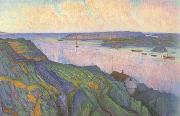 |
Karl Nordstrom
|
|
Swedish Painter, 1855-1923
was a Swedish painter and one of the leading members of Konstnärsförbundet, which he chaired from 1896 until its dissolution in 1920. Born on Gotland, but growing up on Tjörn on the Swedish West Coast, Nordström studied at principskolan, the preparatory school of the Royal Academy of Arts in Stockholm and the private painting school of Edvard Perseus, but was never promoted to the "Antique school" of the Academy but had to continue on his own. Traveling to Paris in 1881, he was influenced by the impressionists. He spent a couple of years in Grez-sur-Loing, the site of an important colony of Scandinavian artists, practising his plein air painting in the strong French sunlight. In 1885, he joined the group of young artists protesting against the policies and leadership of the Academy, and he was ever since 1886 one of the leading members of Konstnärsförbundet, the formalization of the opposition group. He was its chairman from 1896 until its dissolution in 1920. In 1886, he married xylographer and photographer Tekla Lindeström in Paris. Later the same year, he settled on Tjörn, using what he had learnt in France about light and colours to depict the landscape where he had grown up. He spent the summer of 1889 in Visby. Around 1890, he moved from his earlier impressionism towards a more synthetist style. His influences came from Japanese art, which he had encountered in Paris, and from Gauguin, whose paintings he first saw in photographs he had received from Ivan Agueli. One of Nordström's old friends from the time at the Academy and in Perseus' school, Nils Kreuger, had lived in the city of Varberg since 1888. He convinced Nordström to move there in 1892, and they were joined by another of their old friends, Richard Bergh, in 1893.
|
|
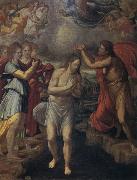 |
Juan Fernandez de Navarrete
|
|
Spanish painter
1526-1579
was a Spanish Mannerist painter, born at Logroño. An illness in infancy deprived Navarrete of his hearing, but at a very early age he began to express his wants by sketching objects with a piece of charcoal. He received his first instructions in art from Fray Vicente de Santo Domingo, a Hieronymite monk at Estella, and also with Becerra. He visited Naples, Rome, Florence and Milan. Pellegrino Tibaldi met him in Rome in 1550. According to most accounts he was for a considerable time the pupil and assistant of Titian at Venice. In 1568 Philip II of Spain summoned him to Madrid with the title of king's painter and a salary, and employed him to execute pictures for the Escorial. During the 1560s and 1570s the huge monastery-palace of El Escorial was still under construction and Philip II was experiencing difficulties in finding good artists for the many large paintings required to decorate it. Titian was very old, and died in 1576, and Tintoretto, Veronese and Anthonis Mor all refused to come to Spain. Philip had to rely on the lesser talent of Navarrete, whose gravedad y decoro ("seriousness and decorum") the king approved. For eleven years until his death Navarrete worked largely on El Escorial. The most celebrated of the works he produced there are a "Nativity" (in which, as in the well-known work on the same subject by Correggio, the light emanates from the infant Saviour), a "Baptism of Christ" (now Prado), and "Abraham Receiving the Three Angels" (one of his last works, dated 1576).
|
|
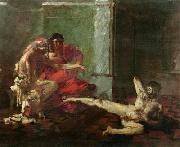 |
Joseph-Noel Sylvestre
|
|
(1847-1926) was a French artist, notable for his studies of classic scenes from antiquity. He was born in Beziers in South-West France on 24 June 1847, training as an artist first in Toulouse under Thomas Couture, then at the École des Beaux-Arts in Paris under Alexandre Cabanel. He was an exponent of the romantic Academic art style, also known as art pompier (fireman's art), examples of which are the Death of Seneca (1875), The Gaul Ducar decapitates the Roman general Flaminus at the Battle of Trasimene (1882), The Sack of Rome by the barbarians in 410 (1890) and François Rude working on the Arc de Triomphe (1893).
|
|
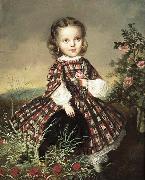 |
Joseph Nitschner
|
|
Description painter
Date of birth 1805(1805)
Location of birth/death Eggenburg Vienna
|
|
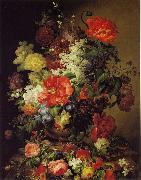 |
Joseph Nigg
|
|
(born 13 October 1782 in Vienna) was an Austrian painter, with painting on porcelain a specialty.
Flower Arrangement by Joseph NiggNigg studied at the Academy of Fine Arts in Vienna with Johann Baptist Drechsler. From 1800 to 1843, Nigg worked as a flower painter in a Viennese porcelain factory. Beginning in 1835, this post also involved holding classes in painting at the factory. With the advent of the Biedermeier Era, flower painting became immensely popular and was also to be found on large porcelain plaques. A piece of this sort, thirty inches in height, was presented by Nigg, on behalf of the Viennese factory, at the The Great Exhibition of 1851 in London.
In addition to working in porcelain, Nigg also created oil paintings, watercolors, and pastel drawings. Two of his paintings, "Grandmother's Bouquet I" and "Grandmother's Bouquet II" have found enduring popularity as poster and print reproductions.
Nigg died in Vienna on September 19, 1863.
|
|
|
|
|
|
|
|
|
|
|
|
|
| Wholesale China Oil Painting Wholesale Oil Painting China Xiamen Portrait Reproduction on canvas Chinese Oil Painting Wholesale USA Oil Painting |
|
|
|
|
|